Raevenlord
News Editor
- Joined
- Aug 12, 2016
- Messages
- 3,755 (1.24/day)
- Location
- Portugal
| System Name | The Ryzening |
|---|---|
| Processor | AMD Ryzen 9 5900X |
| Motherboard | MSI X570 MAG TOMAHAWK |
| Cooling | Lian Li Galahad 360mm AIO |
| Memory | 32 GB G.Skill Trident Z F4-3733 (4x 8 GB) |
| Video Card(s) | Gigabyte RTX 3070 Ti |
| Storage | Boot: Transcend MTE220S 2TB, Kintson A2000 1TB, Seagate Firewolf Pro 14 TB |
| Display(s) | Acer Nitro VG270UP (1440p 144 Hz IPS) |
| Case | Lian Li O11DX Dynamic White |
| Audio Device(s) | iFi Audio Zen DAC |
| Power Supply | Seasonic Focus+ 750 W |
| Mouse | Cooler Master Masterkeys Lite L |
| Keyboard | Cooler Master Masterkeys Lite L |
| Software | Windows 10 x64 |
After announcing its plan for a new, six-month update cycle for Windows 10, which Microsoft is treating as the last, monolithic release of Windows, the Redmond company has now announced its plans for the forthcoming Fall Creators Update (aherm) update.
Microsoft also announced the adoption of a new, Fluent design language, which strikes me as aesthetically pleasing, and a far cry from the Metro interface we've been saddled with since Windows 8. It carries on the bold color schemes, but marries it with a more subdued, less in-you-face style of user interface, and is supposed to encourage developers to design their apps in a way that makes sense on a variety of platforms - which, considering the advent of the Universal Windows Platform, makes all kinds of sense, doesn't it?

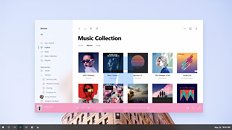
The Fluent Design System will focus on five hallmarks of design: light, depth, motion, material, and scale. Light will help users to know what they should focus on in an app (kinda like those lighting design cues we get in our own video games, right?); depth shows the relations between various interface elements; motion will work towards emphasizing events or actions; material invites users to touch the app probably with different texturing on interactive elements; and scale will help interfaces make the shift from 2D to 3D with Windows Mixed Reality (which Microsoft is positioning as one of the biggest new things for the future.)
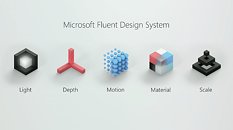
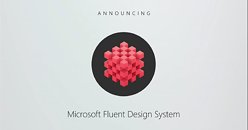
Microsoft if also introducing the Microsoft Graph, which is a timeline of sorts (like a Continuum of your time, eh) which is supposed to more tightly integrate your work across devices with your Windows experience. This means that so long as you possess a Windows system, it will more easily integrate with your other devices. Some features in this Microsoft Graph are:
Timeline, where you can jump back in time to find what you were working on at a given time-frame;
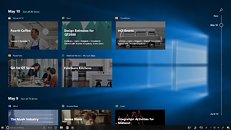
Pick Up Where You Left Off, which empowers Cortana to know and transmit your last piece of work across devices should you so choose, kind of like updating a file on Dropbox, I'd wager;
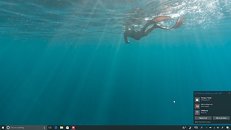
Clipboard, which will duplicate information on your transfer area across your devices, in a cloud-powered way; and OneDrive Files on Demand, which seems a little like magic in that it "allows access to your files in the cloud without having to download them and use storage space on your device." Even online files can apparently be seen in File Explorer and accessed on-demand whenever they are needed.
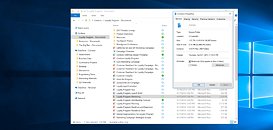
Finally, Microsoft is introducing an entire new image and video editing app, dubbed the Windows Story Remix, which automatically stitches and animates your memories (read, your files), or even your friends' photos and videos, together, creating stories with a soundtrack, theme, and cinematic transitions. This is done automatically, though you can expect to have some user control over this. Microsoft is also integrating mixed reality by adding 3D objects to your photos and videos to tell stories in a whole new way, or turning your photos and videos into your own canvas, to be drawn on with Windows Ink.
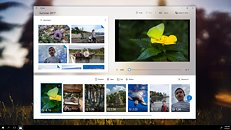
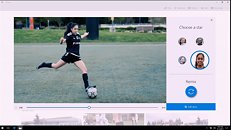
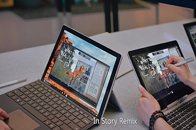
View at TechPowerUp Main Site
Microsoft also announced the adoption of a new, Fluent design language, which strikes me as aesthetically pleasing, and a far cry from the Metro interface we've been saddled with since Windows 8. It carries on the bold color schemes, but marries it with a more subdued, less in-you-face style of user interface, and is supposed to encourage developers to design their apps in a way that makes sense on a variety of platforms - which, considering the advent of the Universal Windows Platform, makes all kinds of sense, doesn't it?


The Fluent Design System will focus on five hallmarks of design: light, depth, motion, material, and scale. Light will help users to know what they should focus on in an app (kinda like those lighting design cues we get in our own video games, right?); depth shows the relations between various interface elements; motion will work towards emphasizing events or actions; material invites users to touch the app probably with different texturing on interactive elements; and scale will help interfaces make the shift from 2D to 3D with Windows Mixed Reality (which Microsoft is positioning as one of the biggest new things for the future.)


Microsoft if also introducing the Microsoft Graph, which is a timeline of sorts (like a Continuum of your time, eh) which is supposed to more tightly integrate your work across devices with your Windows experience. This means that so long as you possess a Windows system, it will more easily integrate with your other devices. Some features in this Microsoft Graph are:
Timeline, where you can jump back in time to find what you were working on at a given time-frame;

Pick Up Where You Left Off, which empowers Cortana to know and transmit your last piece of work across devices should you so choose, kind of like updating a file on Dropbox, I'd wager;

Clipboard, which will duplicate information on your transfer area across your devices, in a cloud-powered way; and OneDrive Files on Demand, which seems a little like magic in that it "allows access to your files in the cloud without having to download them and use storage space on your device." Even online files can apparently be seen in File Explorer and accessed on-demand whenever they are needed.

Finally, Microsoft is introducing an entire new image and video editing app, dubbed the Windows Story Remix, which automatically stitches and animates your memories (read, your files), or even your friends' photos and videos, together, creating stories with a soundtrack, theme, and cinematic transitions. This is done automatically, though you can expect to have some user control over this. Microsoft is also integrating mixed reality by adding 3D objects to your photos and videos to tell stories in a whole new way, or turning your photos and videos into your own canvas, to be drawn on with Windows Ink.



View at TechPowerUp Main Site






